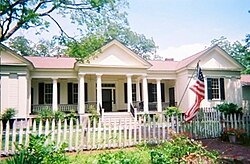Gainesville, Alabama
| Gainesville | |
|---|---|
 Aduston Hall in the Gainesville Historic District |
|
| Location in Sumter County and Alabama | |
| Basic data | |
| State : | United States |
| State : | Alabama |
| County : | Sumter County, Alabama |
| Coordinates : | 32 ° 49 ′ N , 88 ° 9 ′ W |
| Time zone : | Central ( UTC − 6 / −5 ) |
| Residents : | 208 (as of 2010) |
| Population density : | 47.3 inhabitants per km 2 |
| Area : | 4.4 km 2 (approx. 2 mi 2 ) |
| Height : | 39 m |
| Postal code : | 35464 |
| Area code : | +1 205 |
| FIPS : | 01-28768 |
| GNIS ID : | 0157962 |
Gainesville is a small town in northeast Sumter County in central western Alabama . The city council takes the form of a Mayor Council Government .
history
Gainesville was founded around 1835 by Colonel Moses Lewis from New England, who bought 640 acres of land on the Tombigbee River and sold individual plots of it to new settlers. He named the city after George Strother Gaines , an Indian agent for negotiations with the Choctaws , who previously owned the land. The city attracted many settlers from the northern states , so that Main Street was soon nicknamed "Yankee Street". In 1835 the Gainesville Bank was built, which later became so influential that it was allowed to issue its own currency. In 1837, noted author Joseph Glover Baldwin opened a law firm in town. By 1840, Gainesville was the third largest city in Alabama with a population of more than 4,000. The first school opened in 1843 on what is now known as Virginia Hill. From 1842 to 1851, Edmund Pettus , who later became Senator of Alabama, practiced as a lawyer in Gainesville.
In the middle of the 19th century, Gainesville was one of the most important ports on the Tombigbee, and in the meantime even the world's largest inland port for cotton . In 1855 a fire broke out in the city center and destroyed more than 30 original buildings, including the town hall and the post office. On May 9, 1865, Confederate General Nathan Bedford Forrest surrendered to Union forces in Gainesville.
The aftermath of the great fire and civil war, combined with the decline in inland shipping as the major economic driver in Alabama, led to the gradual decline of Gainesville. In 1887, however, the city still had 15 shops and around 1,000 residents.
population
According to the 2010 census, Gainesville has 208 residents. Of these, 82.2 percent are African American , 16.3 percent are white and 1.4 percent are descendants of two or more races. The median household income is estimated at $ 21,000 and the per capita income is $ 16,824.
Culture and sights
The Gainesville Historic District is in the Alabama Register of Landmarks and Heritage entered and includes 33 listed buildings from the 19th century, and the architecture of Federal-style to the Italianate architecture rich, among them three church buildings. The historic park to the north with the bandstand was once the social center in the city's business district, of which hardly any buildings have survived. A nearby obelisk marks the point where General Forrest was surrounded by Edward Canby's forces .
The Gainesville Historic District , Coffin Shop , Colgin Hill , Gibbs House , Main-Yankee Street Historic District , Col. Green G. Mobley House , Gainesville Park and Bandstand, and Laura Watson House are on the National Register of Historic Places registered.
Every year, the second week of March, Gainesville hosts a Civil War reenactment . Buried in the Confederate Cemetery are 250 soldiers who were taken to the city's hospital for treatment after the Battle of Shiloh and who did not survive there. The cannon in the cemetery was cast at the Selma Ordnance and Foundry and recovered from a river in the early 20th century that Confederates had thrown into it to keep it from falling into the hands of the Union.
sons and daughters of the town
- Alexander White Baldwin (1835–1869), US federal judge
- Jaybird Coleman (1896-1950), blues musician
literature
- Gainesville: Alabama's Lost Paradise. In: Cherokee County Herald. July 18, 1990.
- James P. Kaetz: Gainesville . In: Encyclopedia of Alabama . 2015.




